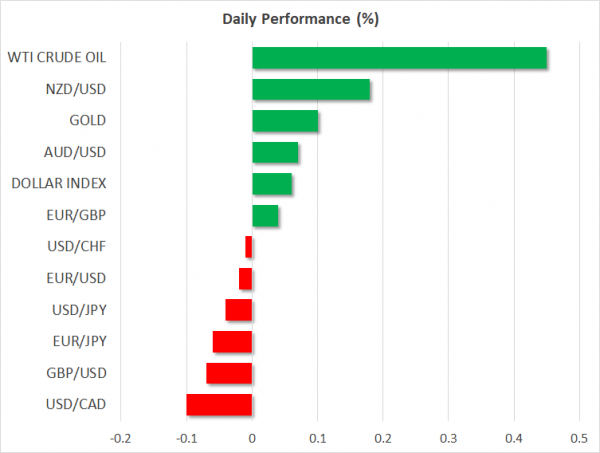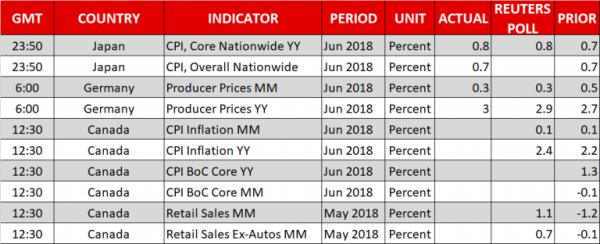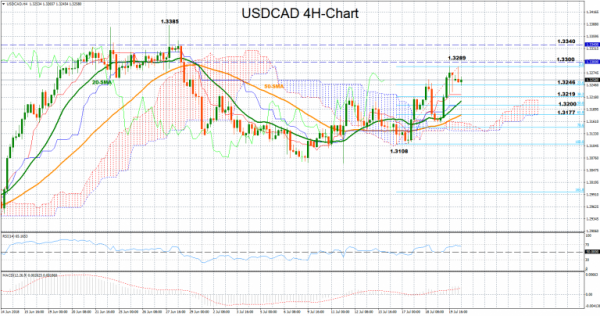Here are the latest developments in global markets:
FOREX: The US dollar posted losses across the board during Friday’s Asian trading; extending the retreat from its highs which started on Thursday. The dollar sell-off was more of a corrective nature for now and was sparked by criticism of the Federal Reserve’s rate hikes by President Donald Trump. The Chinese yuan also dropped, as USDCNY crossed above the 6.80 threshold before coming back down.
STOCKS: Wall Street indices closed negative on Thursday and while the sell-off initially carried over to Asia, many indices managed to trade in the green later. Worries that a looming trade war could have wider repercussions such as a weaker Chinese currency remained a concern –, particularly for Asian stock markets. Europe was expected to open lower by around 0.1-0.2% after a dull session on Thursday.
COMMODITIES: Gold found the chance to rebound from its 1-year low of $1215 an ounce registered the previous day, taking advantage of the weakness of the US dollar. Gold was trading around $1222 an ounce at the time of writing. Oil was consolidating its gains from the previous day, as WTI traded above $68 a barrel. Oil traders were looking forward to the Baker Hughes rig count later in the day to get a better picture of US supply prospects.
Major movers: Antipodeans snap back after sustained losses; dollar/yen back below 113 and euro/dollar above 1.16
The US dollar sold off despite a fresh near 50-year low in weekly initial jobless claims announced the previous day. The trigger for some more profit-taking on the greenback was provided by President Trump, who criticized the Fed’s rate hikes as they could damage the economy. Although US presidents generally shy away from criticizing monetary policy, it is too early to say that Trump’s comments will have any meaningful significance for policymakers. They are unlikely to have an impact but it would also be a mistake to discount the damage to the central bank independence a potential “politicization” of the interest rate debate could do. The White House issued a statement following Trump’s comments saying that the President “respected the central bank’s independence”, he was “not interfering with policy decisions” and was just “reiterating his long-held views on interest rates”. For a dollar that had been perhaps overbought lately, this provided a convenient excuse for taking profits.
Another big currency story was the fresh 1-year low by the Chinese yuan. Dollar/yuan climbed to 6.8128 before dropping back below 6.80 at around 6.7940 because of rumored intervention by state-owned banks. The fact that the yuan could not hold during a session that the US dollar was generally weak, might signal that there is potential for further weakness in the Chinese currency. Indeed there is speculation that the Chinese government might be using the yuan as a weapon in the trade wars, but it is perhaps even more likely that the prospect of a trade war with the US has caused selling of Chinese assets and therefore a market-driven decline in the yuan.
Antipodeans such as the kiwi and the aussie took advantage of the dollar’s weakness to recover a part of their recent losses. One suspects that the recovery would have been even bigger, had it not been for the negative story of the yuan depreciation, which could weigh on countries that export to China.
In other economic news, Japanese inflation for June remained quite low; 0.7% year-on-year for the national headline rate and 0.8% for the core rate. These inflation numbers show that the Bank of Japan is unlikely to be in any hurry to curtail its massive monetary stimulus program.
Day ahead: Canada reports on inflation and retail sales; G20 meeting kicks off in Buenos Aires
Friday’s economic calendar will feature Canadian CPI and retail sales figures, while the global trade turmoil will continue to feed risk-off sentiment as the US shows no appetite to pull back its protectionist tariff measures, whereas the EU and China seek ways to defend their interests.
At 1230 GMT, Statistics Canada is expected to show that overall consumer prices have risen by 2.4%year-on-year in June, 0.2 percentage points faster than in May when the headline CPI stood at 2.2%. Given that Bank of Canada aims to keep the total CPI inflation at the 2.0% midpoint of a target range of 1-3.0% over the medium-term, markets could increase speculation that policymakers are preparing another 25bps rate hike in coming months. The soonest such a rate hike could be delivered would be at the October or December meeting where investors give a chance of 43% and a 54% respectively. While there are is no forecast available for the core, median, or trimmed mean CPI measures, these will be closely reviewed as the central bank uses these volatility-free indices to identify changes in the inflation trend.
Canadian retail sales, which are considered an ideal proxy for household spending, will also be under the spotlight at the same time. After a 1.2% decline in April, analysts believe that retail sales have rebounded substantially by 1.2% m/m in May. If this is the case, that would be the strongest growth registered since December 2017. In the absence of automobiles, the core equivalent is also projected to recover, rising by 0.7% m/m after falling by 0.1% in the previous month.
Should retail sales increase more than analysts predict, signaling that the previous downturn could be temporary and instead inflationary pressures are heating up, something that could be also proved if CPI figures beat forecasts today, the loonie, which is set to close in the red for the second consecutive week, could erase losses. Alternatively, in the wake of disappointing prints which could reduce odds for further stimulus reduction, the loonie could once more find itself under pressure.
Still, trade uncertainties remain a high risk for the loonie as Canada has already started paying steel and aluminum import tariffs to the US, while the NAFTA story continues to hold in the dark as Canada and Mexico have no intentions to leave the pact despite the US pushing to trim the free-trade agreement and sign separate deals with its Canadian and Mexican counterparts. Therefore, trade issues are something policymakers will seriously consider before proceeding with further stimulus reduction.
Developments on the trade front could create headlines during the weekend (or next week) as the Group of 20 finance ministers and central bank presidents will be gathering in Buenos Aires in Argentina, where trade issues might be high on the agenda. The atmosphere though might not be positive as tariff-affected countries are expected to express their frustration over the US import tariffs on steel and aluminum and the retaliatory responses the measures created. Note that at the March G20 meeting, financial representatives criticized protectionism and called for further dialogue which so far had minimal effect.
Meanwhile in oil markets, Baker Hughes is scheduled to issue its report on the numbers of active rigs for oil drilling at 1700 GMT.
In equity markets, earnings season continues with General Electric Corporation being among companies to release quarterly results before the opening bell. Expectations are for the company to post a decline in second-quarter profits.
Technical Analysis: USDCAD could move sideways in short-term
USDCAD is currently in neutral mode, hovering above the Ichimoku cloud near one-month highs in the four-hour chart. While both the RSI and the MACD hold in bullish territory, the former above 50 and the latter above zero and its red signal line, both seem to be slowing down, hinting that the neutral phase might continue in the short-term. Still any upside or downside surprises in Canadian inflation and retail sales figures later today could bring some spikes to the market.
Should the pair head lower in the wake of an upbeat report, nearby support could be found around the 23.6% Fibonacci retracement of 1.3246 of the upleg from 1.3108 to 1.3289. Further downside below that level could then bring the 38.2% Fibonacci of 1.3219 into view, while steeper declines could also break the 1.3200 round level (50% Fibonacci) to test the 61.8% Fibonacci of 1.3177.
Alternatively, a data miss could bring gains to the US dollar, sending the price probably above the 1.3300 round level, where bulls could stop to retest the area around 1.3350, a strong resistance in June. If the price manages to overcome that obstacle, then attention could turn towards the one-year high of 1.3385 unlocked on June 26.















